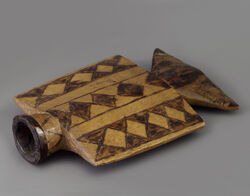A tubular with wings
May 2022

The most primitive smoking pipe is the tubular pipe, a smoking instrument mainly intended for those who want to smoke in a lying position. We regularly see this wish among Native Americans, but this practice also exists elsewhere in the world. What is certain is that the tubular is more common in South America than anywhere else in the world. Specific to the southern tubulars is the wing-shaped mouthpiece that determines the appearance of the object. The pipe shown here with its triangular mouthpiece that is flattened on both sides is a good example of this, but this pipe offers something extra special. The zone between mouthpiece and bowl is not round as usual but strongly flattened into a square that extends widely beyond the actual pipe. Due to this dominant shape, the silhouette of the pipe is completely different from the standard tubular pipe. The attractive added decoration also makes this pipe outstanding. An identical geometric pattern has been painted on either side of the slightly curved surface, consisting of three strips of diagonal squares strung together like a chain. The coloring is playful, in the sense that the middle lane shows dark diamonds, while the outer diamonds, on the other hand, are mirror-imaged and stand in a dark field. At the end of the series, the diamonds are cut in half, accentuating the continuity of the imaginary chain. This tubular originates from the Gran Chaco in Paraguay and is therefore known as Paraquan or Chaco pipe. In terms of function, it is not a proper tobacco pipe. The Chaco use the pipe as a cigar holder. So no pulverized tobacco goes in, but the pipe acts as a holder for tightly rolled tobacco leaves. The art of smoking lay mainly in filling the pipe, because when stopping it is important to roll the leaves in such a way that false air is prevented. That takes some practice. Precisely because the tobacco mainly burns outside the pipe, the pipe itself was spared from burning in. That is partly the reason why this pipe is so beautifully preserved. It is impossible to say how long that has been, but it is certainly a century and a half.
Amsterdam Pipe Museum APM 24.446
Archive object of month